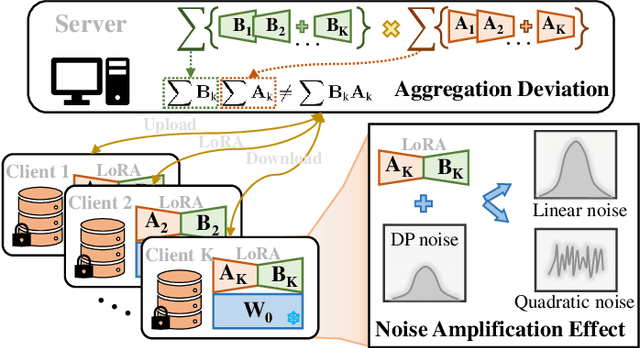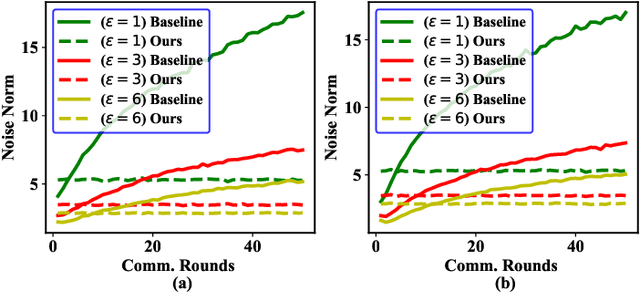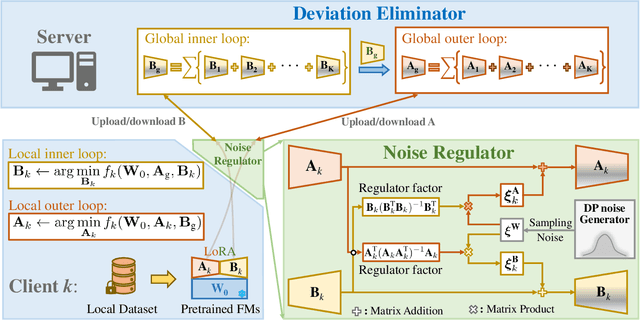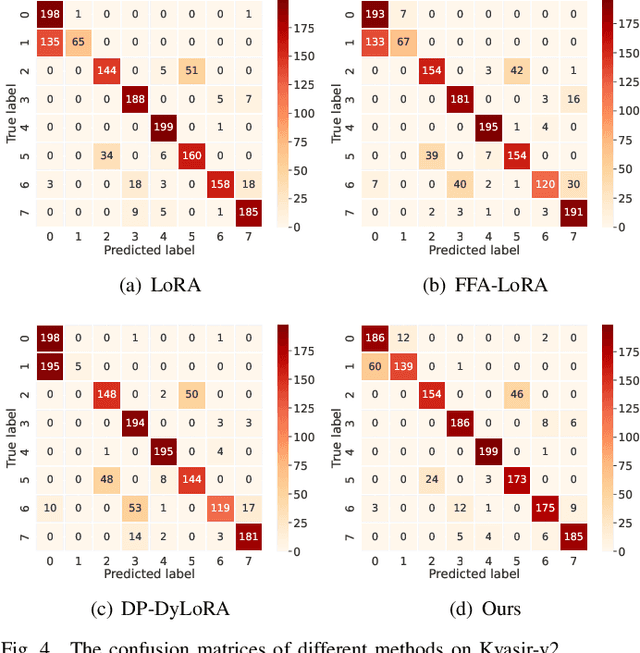Yixuan Yuan
Bridge the Gap Between Visual and Linguistic Comprehension for Generalized Zero-shot Semantic Segmentation
Mar 31, 2025Abstract:Generalized zero-shot semantic segmentation (GZS3) aims to achieve the human-level capability of segmenting not only seen classes but also novel class regions unseen in the training data through introducing the bridge of semantic representations, e.g., word vector. While effective, the way of utilizing one semantic representation to associate the corresponding class and to enable the knowledge transfer from seen to unseen classes is insufficient as well as incompatible with human cognition. Inspired by the observation that humans often use some `part' and `state' information to comprehend the seen objects and imagine unseen classes, we decouple each class into detailed descriptions, including object parts and states. Based on the decoupling formulation, we propose a Decoupled Vision-Language Matching (DeVLMatch) framework, composed of spatial-part (SPMatch) and channel-state (CSMatch) matching modules, for GZS3. In SPMatch, we comprehend objects with spatial part information from both visual and linguistic perspectives and perform graph matching to bridge the gap. In CSMatch, states of objects from the linguistic perspective are matched to compatible channel information from the visual perspective. By decoupling and matching objects across visual and linguistic comprehension, we can explicitly introspect the relationship between seen and unseen classes in fine-grained object part and state levels, thereby facilitating the knowledge transfer from seen to unseen classes in visual space. The proposed DeVLMatch framework surpasses the previous GZS3 methods on standard benchmarks, including PASCAL VOC, COCO-Stuff, and CATARACTS, demonstrating its effectiveness.
DSPFusion: Image Fusion via Degradation and Semantic Dual-Prior Guidance
Mar 30, 2025Abstract:Existing fusion methods are tailored for high-quality images but struggle with degraded images captured under harsh circumstances, thus limiting the practical potential of image fusion. This work presents a \textbf{D}egradation and \textbf{S}emantic \textbf{P}rior dual-guided framework for degraded image \textbf{Fusion} (\textbf{DSPFusion}), utilizing degradation priors and high-quality scene semantic priors restored via diffusion models to guide both information recovery and fusion in a unified model. In specific, it first individually extracts modality-specific degradation priors, while jointly capturing comprehensive low-quality semantic priors. Subsequently, a diffusion model is developed to iteratively restore high-quality semantic priors in a compact latent space, enabling our method to be over $20 \times$ faster than mainstream diffusion model-based image fusion schemes. Finally, the degradation priors and high-quality semantic priors are employed to guide information enhancement and aggregation via the dual-prior guidance and prior-guided fusion modules. Extensive experiments demonstrate that DSPFusion mitigates most typical degradations while integrating complementary context with minimal computational cost, greatly broadening the application scope of image fusion.
X$^{2}$-Gaussian: 4D Radiative Gaussian Splatting for Continuous-time Tomographic Reconstruction
Mar 27, 2025Abstract:Four-dimensional computed tomography (4D CT) reconstruction is crucial for capturing dynamic anatomical changes but faces inherent limitations from conventional phase-binning workflows. Current methods discretize temporal resolution into fixed phases with respiratory gating devices, introducing motion misalignment and restricting clinical practicality. In this paper, We propose X$^2$-Gaussian, a novel framework that enables continuous-time 4D-CT reconstruction by integrating dynamic radiative Gaussian splatting with self-supervised respiratory motion learning. Our approach models anatomical dynamics through a spatiotemporal encoder-decoder architecture that predicts time-varying Gaussian deformations, eliminating phase discretization. To remove dependency on external gating devices, we introduce a physiology-driven periodic consistency loss that learns patient-specific breathing cycles directly from projections via differentiable optimization. Extensive experiments demonstrate state-of-the-art performance, achieving a 9.93 dB PSNR gain over traditional methods and 2.25 dB improvement against prior Gaussian splatting techniques. By unifying continuous motion modeling with hardware-free period learning, X$^2$-Gaussian advances high-fidelity 4D CT reconstruction for dynamic clinical imaging. Project website at: https://x2-gaussian.github.io/.
MAP: Evaluation and Multi-Agent Enhancement of Large Language Models for Inpatient Pathways
Mar 17, 2025Abstract:Inpatient pathways demand complex clinical decision-making based on comprehensive patient information, posing critical challenges for clinicians. Despite advancements in large language models (LLMs) in medical applications, limited research focused on artificial intelligence (AI) inpatient pathways systems, due to the lack of large-scale inpatient datasets. Moreover, existing medical benchmarks typically concentrated on medical question-answering and examinations, ignoring the multifaceted nature of clinical decision-making in inpatient settings. To address these gaps, we first developed the Inpatient Pathway Decision Support (IPDS) benchmark from the MIMIC-IV database, encompassing 51,274 cases across nine triage departments and 17 major disease categories alongside 16 standardized treatment options. Then, we proposed the Multi-Agent Inpatient Pathways (MAP) framework to accomplish inpatient pathways with three clinical agents, including a triage agent managing the patient admission, a diagnosis agent serving as the primary decision maker at the department, and a treatment agent providing treatment plans. Additionally, our MAP framework includes a chief agent overseeing the inpatient pathways to guide and promote these three clinician agents. Extensive experiments showed our MAP improved the diagnosis accuracy by 25.10% compared to the state-of-the-art LLM HuatuoGPT2-13B. It is worth noting that our MAP demonstrated significant clinical compliance, outperforming three board-certified clinicians by 10%-12%, establishing a foundation for inpatient pathways systems.
FedBM: Stealing Knowledge from Pre-trained Language Models for Heterogeneous Federated Learning
Feb 24, 2025Abstract:Federated learning (FL) has shown great potential in medical image computing since it provides a decentralized learning paradigm that allows multiple clients to train a model collaboratively without privacy leakage. However, current studies have shown that data heterogeneity incurs local learning bias in classifiers and feature extractors of client models during local training, leading to the performance degradation of a federation system. To address these issues, we propose a novel framework called Federated Bias eliMinating (FedBM) to get rid of local learning bias in heterogeneous federated learning (FL), which mainly consists of two modules, i.e., Linguistic Knowledge-based Classifier Construction (LKCC) and Concept-guided Global Distribution Estimation (CGDE). Specifically, LKCC exploits class concepts, prompts and pre-trained language models (PLMs) to obtain concept embeddings. These embeddings are used to estimate the latent concept distribution of each class in the linguistic space. Based on the theoretical derivation, we can rely on these distributions to pre-construct a high-quality classifier for clients to achieve classification optimization, which is frozen to avoid classifier bias during local training. CGDE samples probabilistic concept embeddings from the latent concept distributions to learn a conditional generator to capture the input space of the global model. Three regularization terms are introduced to improve the quality and utility of the generator. The generator is shared by all clients and produces pseudo data to calibrate updates of local feature extractors. Extensive comparison experiments and ablation studies on public datasets demonstrate the superior performance of FedBM over state-of-the-arts and confirm the effectiveness of each module, respectively. The code is available at https://github.com/CUHK-AIM-Group/FedBM.
Polyp-Gen: Realistic and Diverse Polyp Image Generation for Endoscopic Dataset Expansion
Jan 29, 2025



Abstract:Automated diagnostic systems (ADS) have shown significant potential in the early detection of polyps during endoscopic examinations, thereby reducing the incidence of colorectal cancer. However, due to high annotation costs and strict privacy concerns, acquiring high-quality endoscopic images poses a considerable challenge in the development of ADS. Despite recent advancements in generating synthetic images for dataset expansion, existing endoscopic image generation algorithms failed to accurately generate the details of polyp boundary regions and typically required medical priors to specify plausible locations and shapes of polyps, which limited the realism and diversity of the generated images. To address these limitations, we present Polyp-Gen, the first full-automatic diffusion-based endoscopic image generation framework. Specifically, we devise a spatial-aware diffusion training scheme with a lesion-guided loss to enhance the structural context of polyp boundary regions. Moreover, to capture medical priors for the localization of potential polyp areas, we introduce a hierarchical retrieval-based sampling strategy to match similar fine-grained spatial features. In this way, our Polyp-Gen can generate realistic and diverse endoscopic images for building reliable ADS. Extensive experiments demonstrate the state-of-the-art generation quality, and the synthetic images can improve the downstream polyp detection task. Additionally, our Polyp-Gen has shown remarkable zero-shot generalizability on other datasets. The source code is available at https://github.com/CUHK-AIM-Group/Polyp-Gen.
ConcealGS: Concealing Invisible Copyright Information in 3D Gaussian Splatting
Jan 07, 2025Abstract:With the rapid development of 3D reconstruction technology, the widespread distribution of 3D data has become a future trend. While traditional visual data (such as images and videos) and NeRF-based formats already have mature techniques for copyright protection, steganographic techniques for the emerging 3D Gaussian Splatting (3D-GS) format have yet to be fully explored. To address this, we propose ConcealGS, an innovative method for embedding implicit information into 3D-GS. By introducing the knowledge distillation and gradient optimization strategy based on 3D-GS, ConcealGS overcomes the limitations of NeRF-based models and enhances the robustness of implicit information and the quality of 3D reconstruction. We evaluate ConcealGS in various potential application scenarios, and experimental results have demonstrated that ConcealGS not only successfully recovers implicit information but also has almost no impact on rendering quality, providing a new approach for embedding invisible and recoverable information into 3D models in the future.
LoCo: Low-Contrast-Enhanced Contrastive Learning for Semi-Supervised Endoscopic Image Segmentation
Dec 03, 2024Abstract:The segmentation of endoscopic images plays a vital role in computer-aided diagnosis and treatment. The advancements in deep learning have led to the employment of numerous models for endoscopic tumor segmentation, achieving promising segmentation performance. Despite recent advancements, precise segmentation remains challenging due to limited annotations and the issue of low contrast. To address these issues, we propose a novel semi-supervised segmentation framework termed LoCo via low-contrast-enhanced contrastive learning (LCC). This innovative approach effectively harnesses the vast amounts of unlabeled data available for endoscopic image segmentation, improving both accuracy and robustness in the segmentation process. Specifically, LCC incorporates two advanced strategies to enhance the distinctiveness of low-contrast pixels: inter-class contrast enhancement (ICE) and boundary contrast enhancement (BCE), enabling models to segment low-contrast pixels among malignant tumors, benign tumors, and normal tissues. Additionally, a confidence-based dynamic filter (CDF) is designed for pseudo-label selection, enhancing the utilization of generated pseudo-labels for unlabeled data with a specific focus on minority classes. Extensive experiments conducted on two public datasets, as well as a large proprietary dataset collected over three years, demonstrate that LoCo achieves state-of-the-art results, significantly outperforming previous methods. The source code of LoCo is available at the URL of https://github.com/AnoK3111/LoCo.
DEeR: Deviation Eliminating and Noise Regulating for Privacy-preserving Federated Low-rank Adaptation
Oct 16, 2024



Abstract:Integrating low-rank adaptation (LoRA) with federated learning (FL) has received widespread attention recently, aiming to adapt pretrained foundation models (FMs) to downstream medical tasks via privacy-preserving decentralized training. However, owing to the direct combination of LoRA and FL, current methods generally undergo two problems, i.e., aggregation deviation, and differential privacy (DP) noise amplification effect. To address these problems, we propose a novel privacy-preserving federated finetuning framework called \underline{D}eviation \underline{E}liminating and Nois\underline{e} \underline{R}egulating (DEeR). Specifically, we firstly theoretically prove that the necessary condition to eliminate aggregation deviation is guaranteing the equivalence between LoRA parameters of clients. Based on the theoretical insight, a deviation eliminator is designed to utilize alternating minimization algorithm to iteratively optimize the zero-initialized and non-zero-initialized parameter matrices of LoRA, ensuring that aggregation deviation always be zeros during training. Furthermore, we also conduct an in-depth analysis of the noise amplification effect and find that this problem is mainly caused by the ``linear relationship'' between DP noise and LoRA parameters. To suppress the noise amplification effect, we propose a noise regulator that exploits two regulator factors to decouple relationship between DP and LoRA, thereby achieving robust privacy protection and excellent finetuning performance. Additionally, we perform comprehensive ablated experiments to verify the effectiveness of the deviation eliminator and noise regulator. DEeR shows better performance on public medical datasets in comparison with state-of-the-art approaches. The code is available at https://github.com/CUHK-AIM-Group/DEeR.
AutoPET Challenge: Tumour Synthesis for Data Augmentation
Sep 12, 2024



Abstract:Accurate lesion segmentation in whole-body PET/CT scans is crucial for cancer diagnosis and treatment planning, but limited datasets often hinder the performance of automated segmentation models. In this paper, we explore the potential of leveraging the deep prior from a generative model to serve as a data augmenter for automated lesion segmentation in PET/CT scans. We adapt the DiffTumor method, originally designed for CT images, to generate synthetic PET-CT images with lesions. Our approach trains the generative model on the AutoPET dataset and uses it to expand the training data. We then compare the performance of segmentation models trained on the original and augmented datasets. Our findings show that the model trained on the augmented dataset achieves a higher Dice score, demonstrating the potential of our data augmentation approach. In a nutshell, this work presents a promising direction for improving lesion segmentation in whole-body PET/CT scans with limited datasets, potentially enhancing the accuracy and reliability of cancer diagnostics.
 Add to Chrome
Add to Chrome Add to Firefox
Add to Firefox Add to Edge
Add to Edge